Your Skin Redness May Actually Have Something To Do With Your Veins
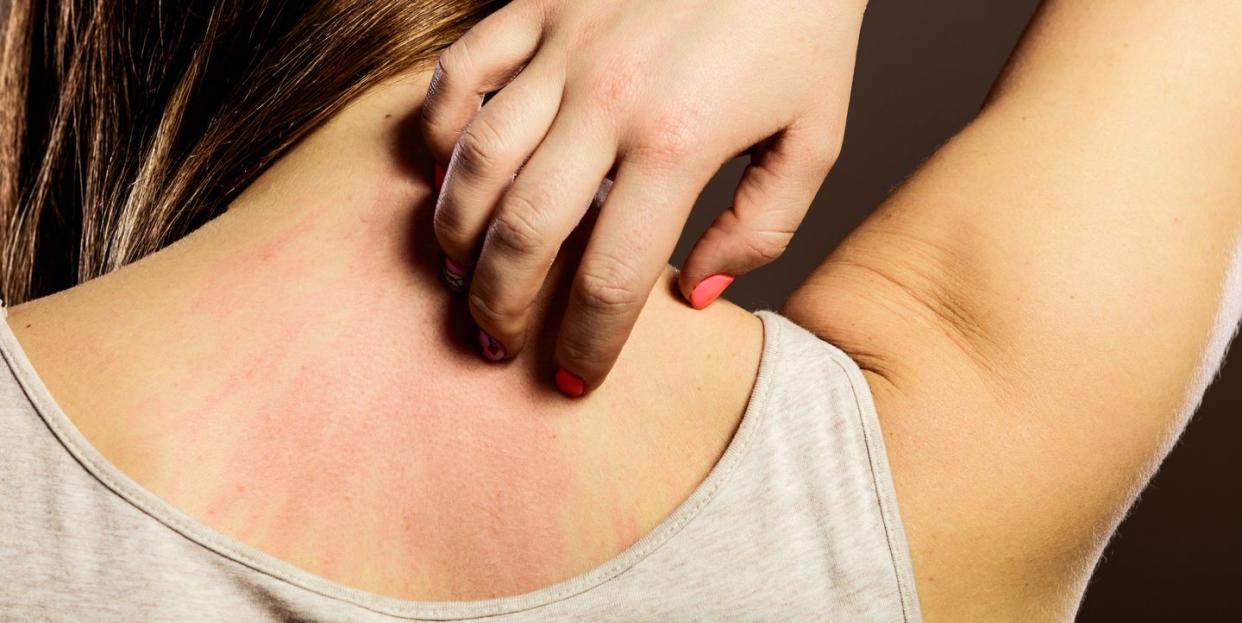
Noticing a new rash? Or maybe a red bump you haven’t seen before? Perhaps a bite or sting is causing unexpected symptoms? Whatever may be the case, skin redness is a very common occurrence. There’s a wide range of conditions, varying in severity, that could be causing it.
Pinning down the root of the problem is easier said than done. Know that the most common reason to experience skin redness is skin barrier damage or irritation, according to Lindsey Zubritsky, MD, a dermatologist based in Mississippi and a fellow of the American Academy of Dermatology.
“Our skin barrier is the part of our skin that separates and protects us from external factors like UV rays, pollution, and other environmental aggressors," Dr. Zubritsky explains. "When it is damaged for any reason, not only do we experience skin redness but also other symptoms like flaking, peeling, stinging, burning, and dryness."
That night cream or face scrub you just started using could be to blame because it may contain aggressive ingredients like retinols and chemical exfoliants. Sunburns and bug bites are also common causes for skin redness. Needless to say, conditions, such as rosacea and eczema, could be the culprit of irritated skin as well.
Skin redness often comes with itching, warmth, bumps, and swelling, says Gina Charles, DO, a family physician and the owner of Serenity Aesthetics & Wellness. How long it lasts can range anywhere from a few days to months depending on the cause.
Here are the most common causes of skin redness and the photos of each to help you figure out what's going on.
Meet the experts: Gina Charles, DO, is a family physician who is recognized by the American College of Osteopathic Family Physicians as one of their female physician leaders. She is also an executive board member of National Coalition of 100 Black Women Inc. – Harrisburg chapter.
Lindsey Zubritsky, MD, is a dermatologist specializing in general medical dermatology, surgical, cosmetics, and pediatric dermatology. She serves as an editor for the Journal of the American Academy of Dermatology.
Chris Adigun, MD, is a dermatologist in Chapel Hill, North Carolina. She practices both general and cosmetic dermatology. She also specializes in nail disorders and is passionate about educating the public on the harmful effects of UV rays and skin cancer.
Shingles
If you’ve had chickenpox, the shingles virus (a.k.a. the varicella zoster virus) is already inside your body. If the virus becomes reactivated, it can cause painful, red rashes on your skin. They come with fluid-filled blisters, fever, headache, sensitivity to light, or fatigue. These rashes typically appear on one side of your body only and stretch across it like a band.
While it's most common in people over 50, shingles can be triggered by stress and could pop up in those with a weakened immune system, per the Cleveland Clinic.
Call a doctor immediately if you suspect you might have shingles, as they will need to prescribe you antiviral medication to suppress the virus and speed up recovery. They may also give you a lidocaine cream to numb the areas affected by the rash. You can also take over-the-counter pain meds to cope with the discomfort. While you recover, it's important to keep from scratching it and cover the rashes to prevent spreading chickenpox to others.
Any skin redness associated with the shingles rash will go away once the virus runs its course. Most cases last three to five weeks, according to the National Institute on Aging.
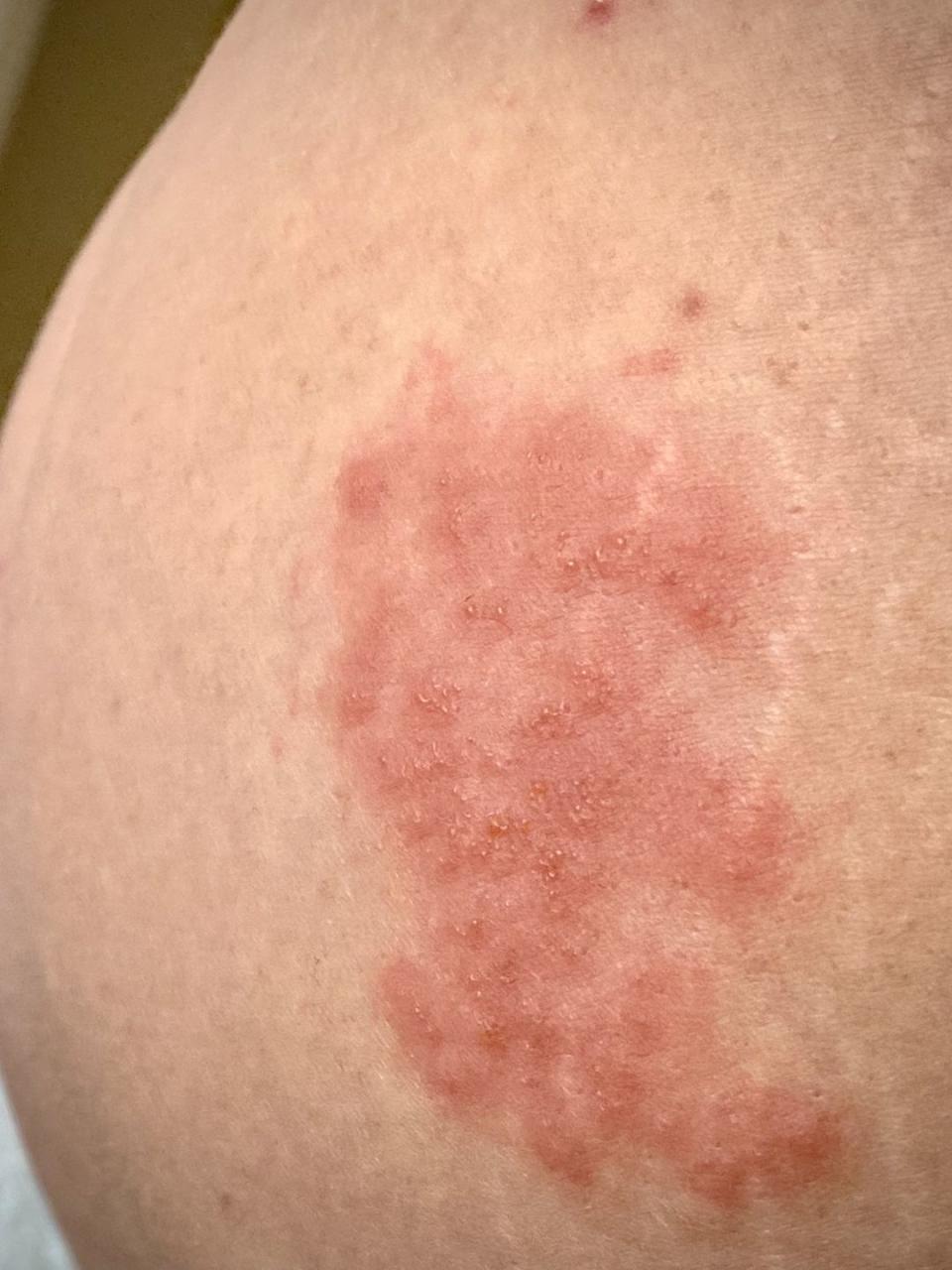
Ringworm
If your red spot looks circular, it could be ringworm. Ringworm is a fungal infection that presents as a red, itchy, circular rash. The fungi that cause it can live on the skin, surfaces, and household items like clothing, towels, and bedding, the CDC says. It can affect the feet, palms, groin, or scalp.
With this infection, the itchy ring is typically the only symptom. But if you do see a suspicious red, round rash that doesn't go away, get in touch with your doc because you'll need topical treatment to get rid of it.
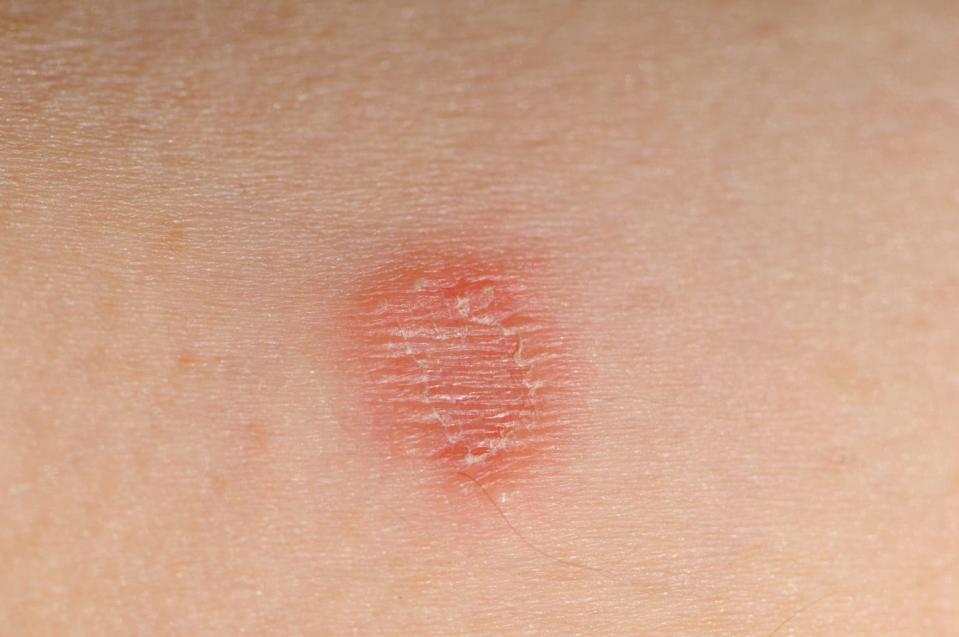
Psoriasis
Psoriasis is an autoimmune condition that causes skin cells to build up. The extra skin cells form itchy, scaly, red patches. In addition to red, patchy skin, you may have joint pain or pitted or thickened nails. In skin of color, the rashes appear more dark brown or violet, according to Dr. Charles.
While there’s no cure for psoriasis, a doctor can help you manage the symptoms. Topical steroids are usually used to reduce redness and irritation, says Dr. Charles, such as hydrocortisone creams and ointments.
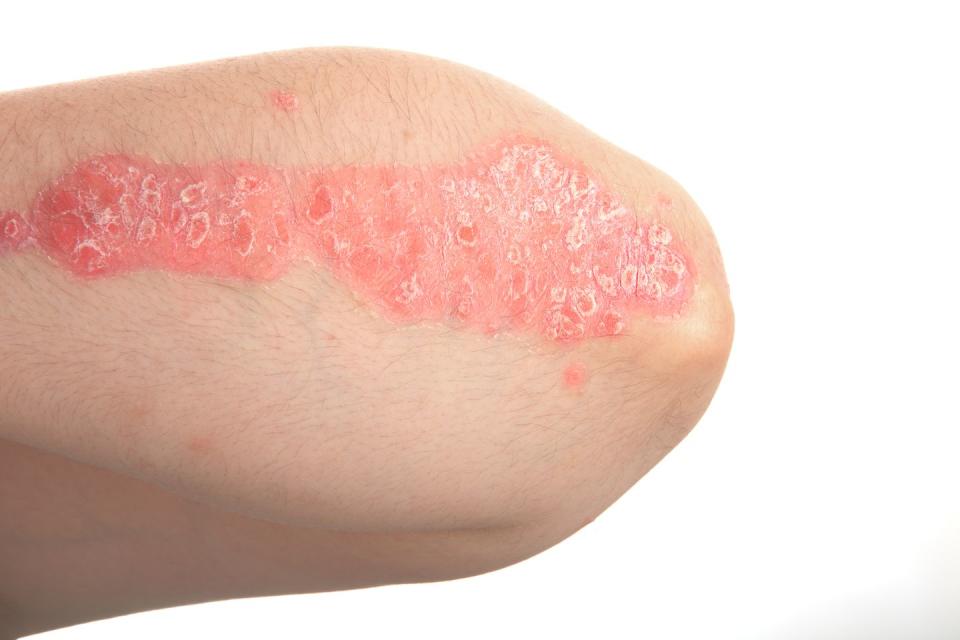
Heat Rash
While it’s more common to see heat rash on babies, adults sometimes have it too. It happens when blocked pores trap sweat underneath your skin, causing lots of red bumps. Usually, these bumps show up in skin folds or where your clothing causes friction. Look for heat rash on your neck, shoulders, chest, armpits, elbow creases, and groin.
Heat rash typically takes care of itself, but you should consult a doctor if the bumps don’t disappear after a few days.
Bites and stings
No surprise here: Lots of different bites and stings can cause angry, red bumps. "This is the body’s immune reaction to a foreign substance," Dr. Zubritsky says. The swollen, itchy redness can last several days, and typically come from mosquitoes, chiggers, or gnats. Other bites and stings can come from spiders, ants, bees, jellyfish, sea lice, ticks, fleas, and many other types of insects and animals. Most of the time, a bite or sting causes a mild reaction that goes away on its own. But, sometimes, they can get infected.
The less common but more serious bites that Dr. Zubritsky warns readers about include bee or wasp stings, spider bites, or tick bites. If your bite or sting gets too swollen or causes an allergic reaction—you find it difficult to breathe or feel dizzy and nauseous—get help.
Keep calamine lotion in your medicine cabinet, says Dr. Charles—they can come in handy when you get bitten. "It reduces redness and itchiness associated with sun burn, Poison Ivy, insect bites, and other mild skin conditions," she says.
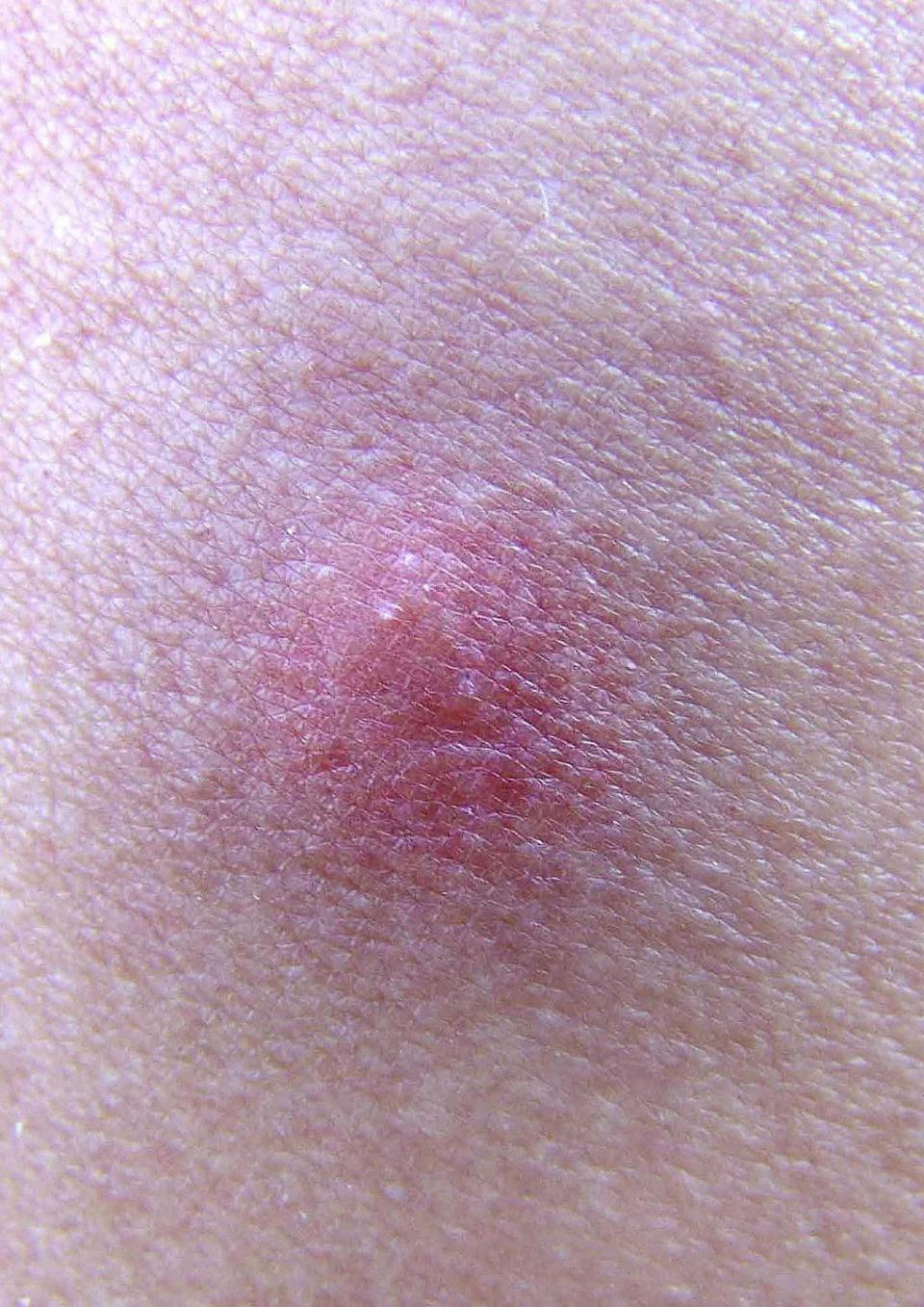
Skin infections
Skin infections can come from bacteria, viruses, fungi, or parasites, which means flare-ups can look quite different depending on the cause. Some infections are surface level, while others go deep into the tissue. Depending on the type of infection you have, you could experience rashes, swelling, pain, pus, and itching.
Some infections will go away on their own or with an over-the-counter cream or lotion. Dr. Charles advises patients with bacterial skin infections to take antibiotics to reduce the redness. First-generation cephalosporins is one of the most effective medicines used to treat them, according to a 2018 study published in the Annals of Dermatology.
Other skin infections may need medical treatment, so see your doctor to figure out what's going on.
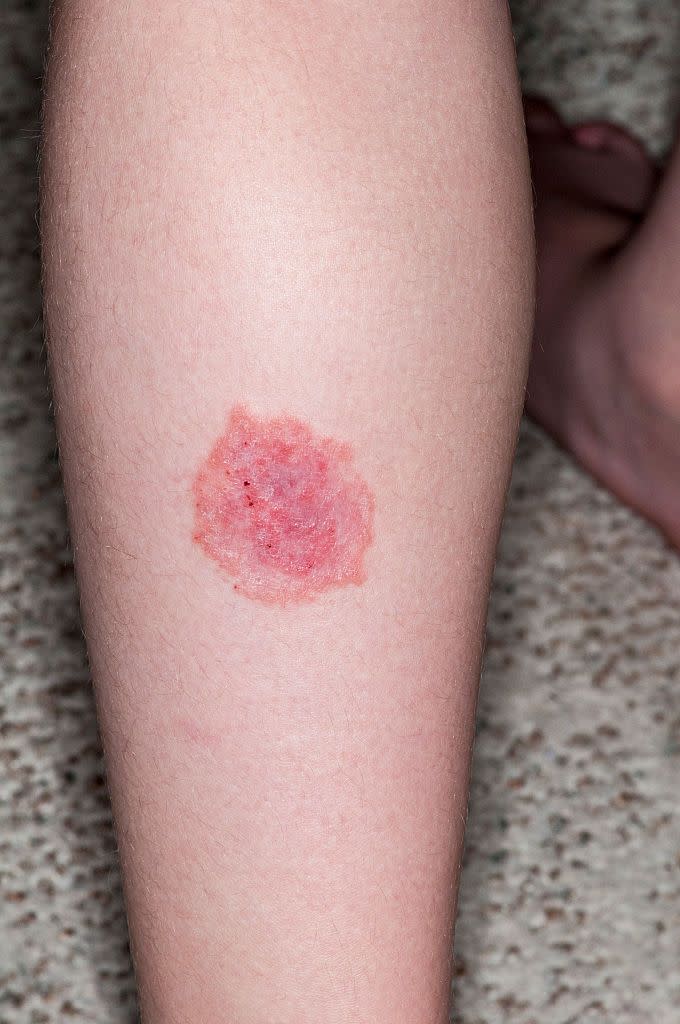
Thrombophlebitis
If you have thrombophlebitis, you’ll see not only redness, but also a large lump—usually on your arm or leg. This type of inflammation causes blood clots to clog a vein. Other than redness, you’ll experience pain, swelling, warmth, and tenderness.
The Mayo Clinic recommends applying heat to the painful area, elevating the affected limb, using an over-the-counter nonsteroidal anti-inflammatory drug, and wearing compression socks to alleviate symptoms. Ibuprofen is often effective for reducing inflammation, and the condition usually improves on its own after some time. However, if you have a swollen vein, see a doctor right away.
Angioedema
Angioedema is swelling underneath the skin, sometimes connected with hives. Often, swelling from angioedema is around your face or lips and may even manifest in a swollen mouth or eyes. The welts may be itchy and painful and may turn into a pale color if irritated. Other symptoms include abdominal cramping and breathing difficulty.
It usually clears up on its own, but check with a doctor if the swelling lasts more than a few days. An over-the-counter antihistamine or a cool, wet washcloth may just be your solution to the swelling.
Scarlet fever
If you’ve recently had strep throat, watch out for scarlet fever. It can develop from the same bacteria (though it's most common in children). Look for a red, bumpy rash, strawberry-colored tongue, flushed face, fever, sore throat, and red lines in the folds of skin around the armpits, knees, neck, groin, and elbows.
The typical scarlet fever treatment requires 10 days of antibiotics. Call a doctor right away if you suspect scarlet fever. Often they will prescribe penicillin or amoxicillin, according to the NHS.
Cellulitis
Cellulitis is a specific type of skin infection caused by bacteria. Infected skin is typically very red, swollen, tender, warm and painful to the touch. If the infection is left untreated, it can spread throughout your body and quickly become life-threatening.
Get to a doctor if you have a red, swollen rash that spreads quickly, accompanied by a fever. You may need an antibiotic, such as dicloxacillin, cephalexin, or trimethoprim with sulfamethoxazole, to treat your cellulitis, according to MedScape.
Drug allergies
Hours, days, or weeks after taking a new medication, you might find a red, bumpy rash. Any medication, whether over-the-counter or prescription, can cause an allergic reaction like this.
Antihistamines, like Benadryl, or corticosteroids for more severe reactions are advised by The Mayo Clinic for treating this allergic reaction.
Some medication allergies can be serious and make it difficult to breathe. If you have any trouble breathing, call your doctor. Even with mild reactions, it’s important to see your doctor and figure out a new medication you can take instead.
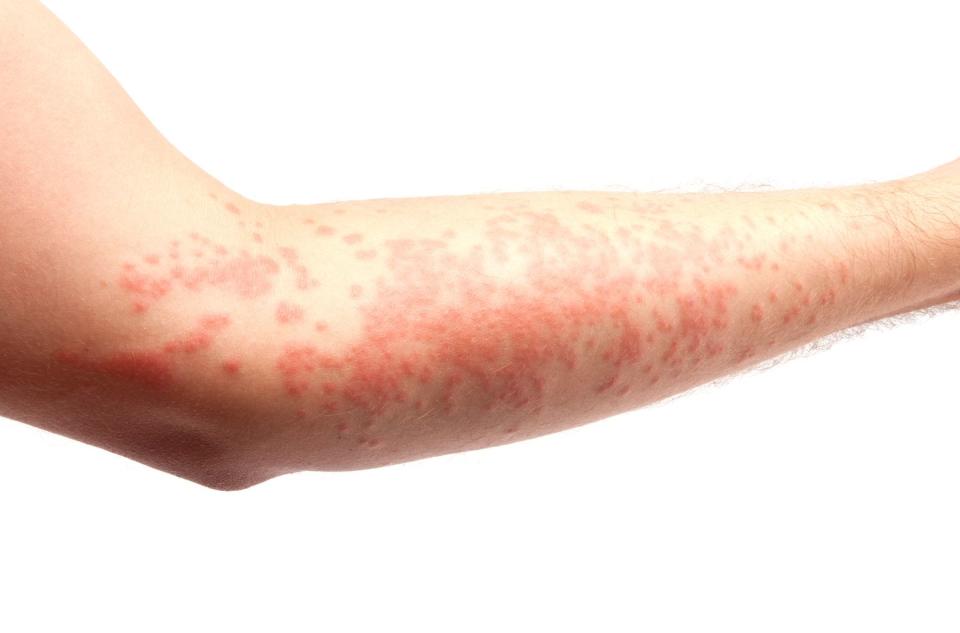
Chemical burn
From DIY projects to cleaning hacks, there are lots of ways you might accidentally get a chemical burn. Usually, it’s pretty obvious what caused the burn. Whichever body part you spilled chemicals on or submerged in chemicals will become red and painful. Dizziness, itchiness, burning, and hives are all also symptoms of a chemical burn.
If the burn is minor enough, you can treat it by yourself. The Mayo Clinic suggests flushing the wound with cool water for at least 10 minutes and bandaging it loosely in a clean cloth. However, if the burn is bigger than three inches or looks deep, it’s best to go to urgent care for help ASAP.
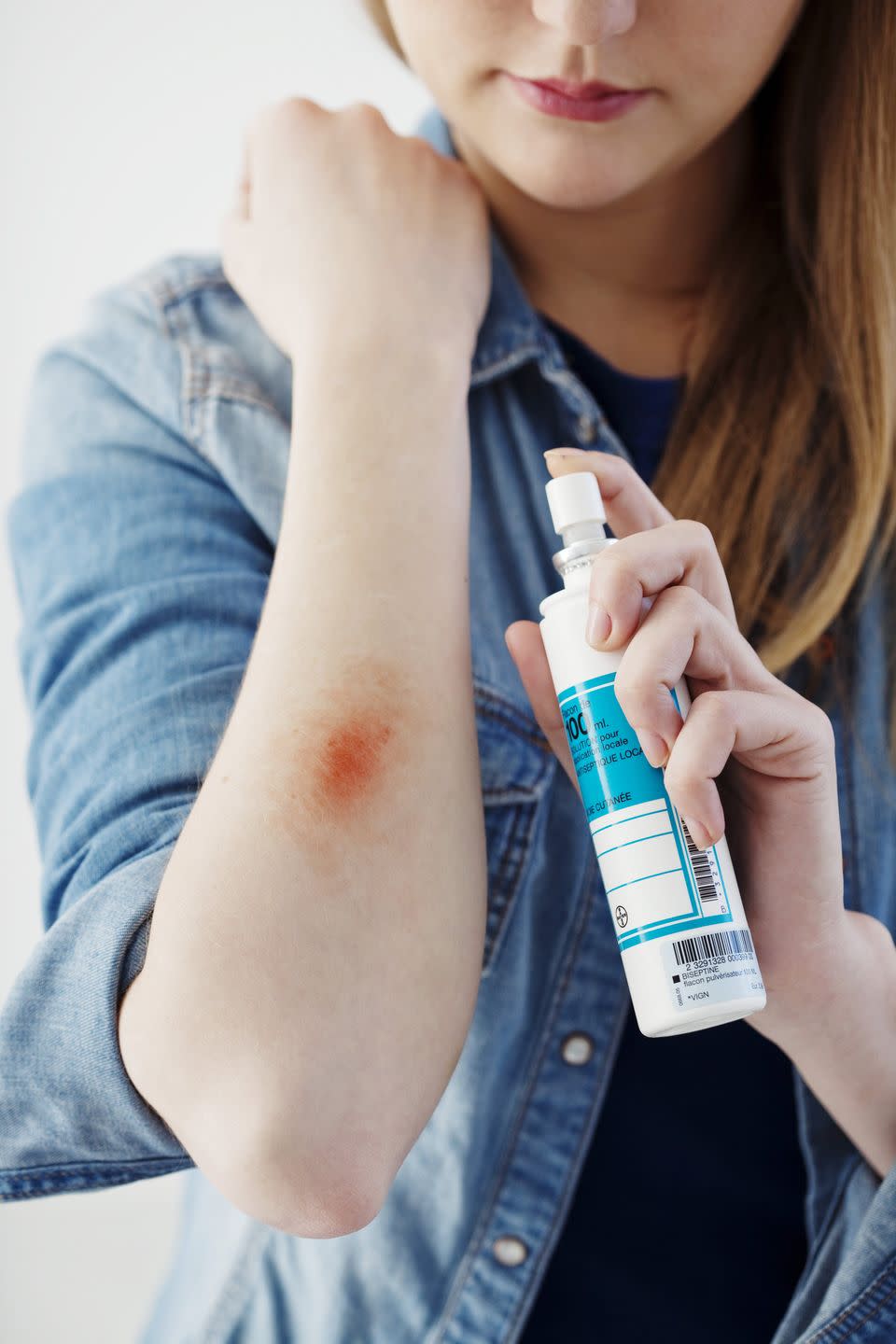
Contact dermatitis
If something weird is going on with your skin, the first question you get is often, “Did you switch soaps recently?”
Soaps and cosmetics can cause a reaction called contact dermatitis, which is essentially a red, itchy rash caused by direct contact with an allergen. Fragrances, jewelry, and sometimes even plants can also cause this reaction. See your doctor if the rash is interfering with your sleep, if it’s painful and widespread, and if it doesn’t get better within three weeks.
Applying a one percent hydrocortisone cream or ointment, such as Cortizone 10, often helps treat contact dermatitis, according to The Mayo Clinic. Soaking the infected area in a cool bath with an oatmeal-based bath product also tends to help.
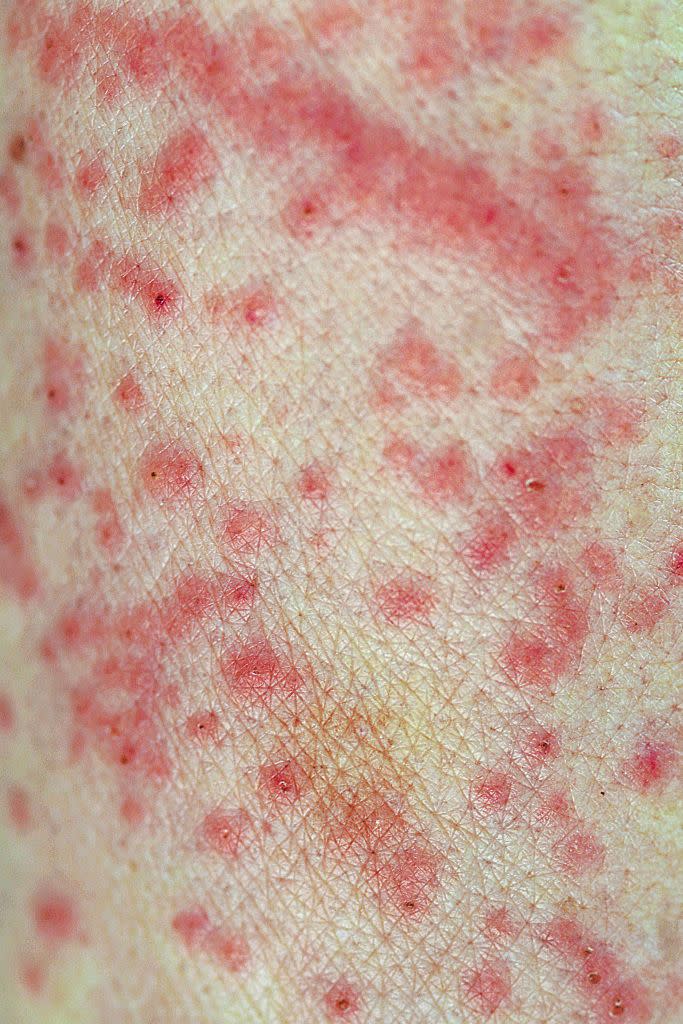
Burns
No big shock here: Burns can cause red skin. Depending on how severe the burn is, you may or may not need medical treatment. First-degree burns are minor and can be treated at home because they only affect the top layer of skin. Second- and third-degree burns, however, are more serious and will probably need a doctor’s attention to avoid infection and scarring. Blistering, swelling, and white or charred skin are other symptoms of a skin burn.
If you suspect you're dealing with a burn, do not apply lotions or creams to your skin, especially if they contain fragrance. Instead, apply a petroleum-based ointment, such as Aquaphor or Vaseline, two to three times per day.
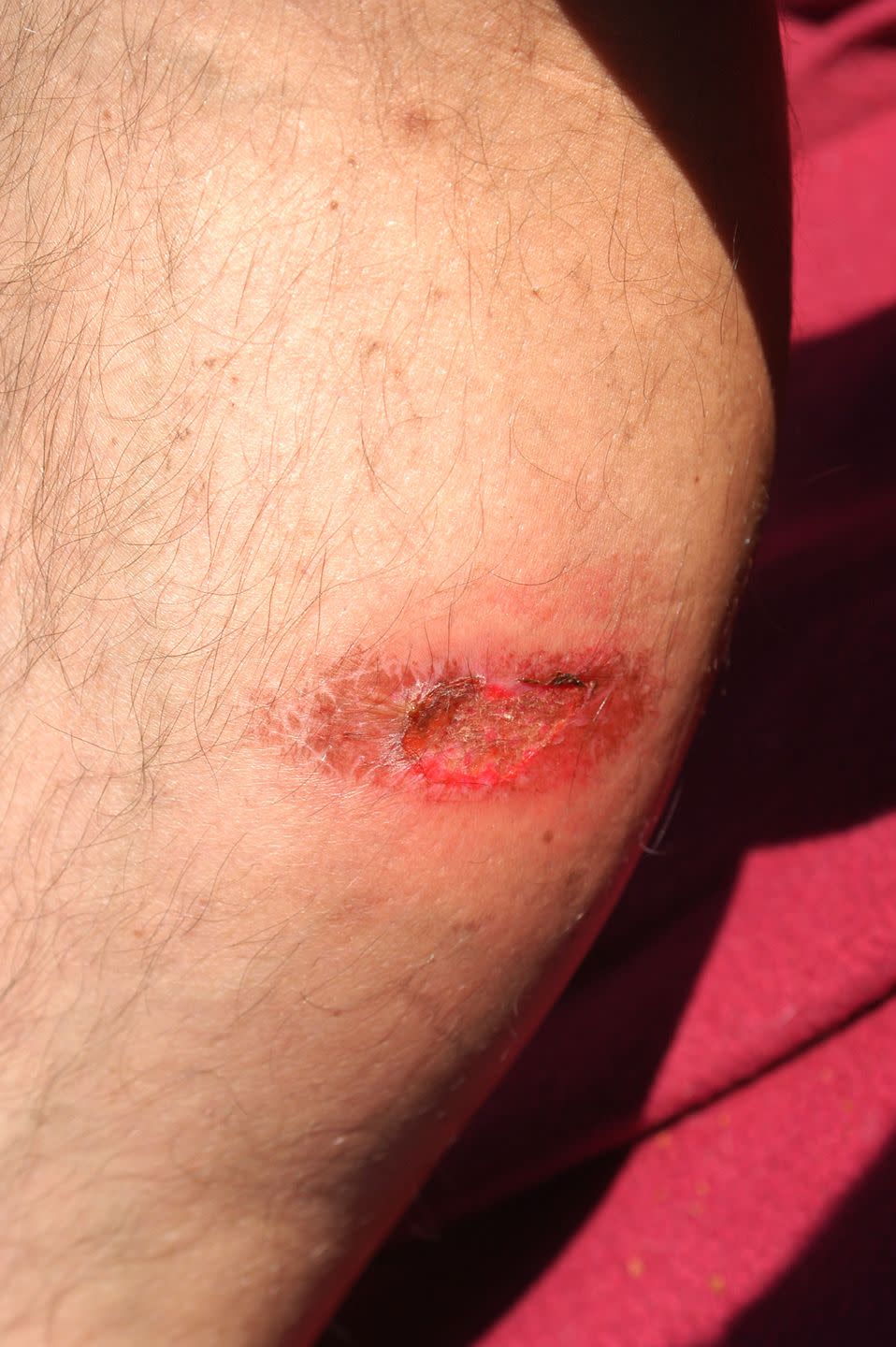
Eczema
Eczema, also known as atopic dermatitis, is a skin condition that causes red and itchy bumps. "Those who have eczema have a weakened skin barrier, which leads to a continuous cycle of inflammation and redness," Dr. Zubritsky explains. "This is particularly worsened during the winter time when there is less humidity in the air or when irritating skin products are used, particularly ones with fragrances." While other conditions may only last a few days, the redness from eczema could last months, notes Dr. Charles.
Although it most commonly affects children, you should call a doctor if your facial skin is red and itchy, especially if you had eczema as a child, says Chris Adigun, MD, a dermatologist in Chapel Hill, North Carolina.
While, there is no cure for eczema, a dermatologist can help you manage your symptoms. Dr. Zubritsky recommends products with niacinamide to address the redness caused by this condition. "Niacinamide is an anti-inflammatory and an antioxidant that works to improve skin’s outer layer and calm the skin," she says.
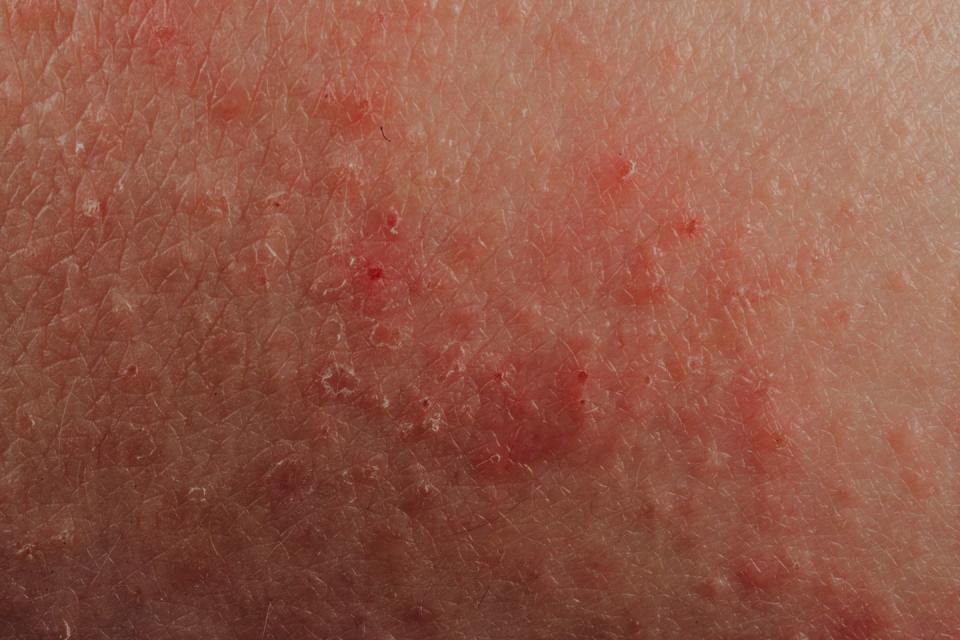
Rosacea
Rosacea is a chronic inflammatory skin disease that mostly causes redness in the face and noticeable blood vessels. Symptoms of rosacea also include skin sensitivity, specifically burning and stinging, flushing, acne-like pimples, and the inability to tolerate many different skincare products, Dr. Zubritsky says.
Make an appointment with a dermatologist if the flushing or sensitivity becomes intolerable. “I also recommend seeing a dermatology expert for prescription treatments for papules and pustules associated with rosacea,” Dr. Adigun notes.
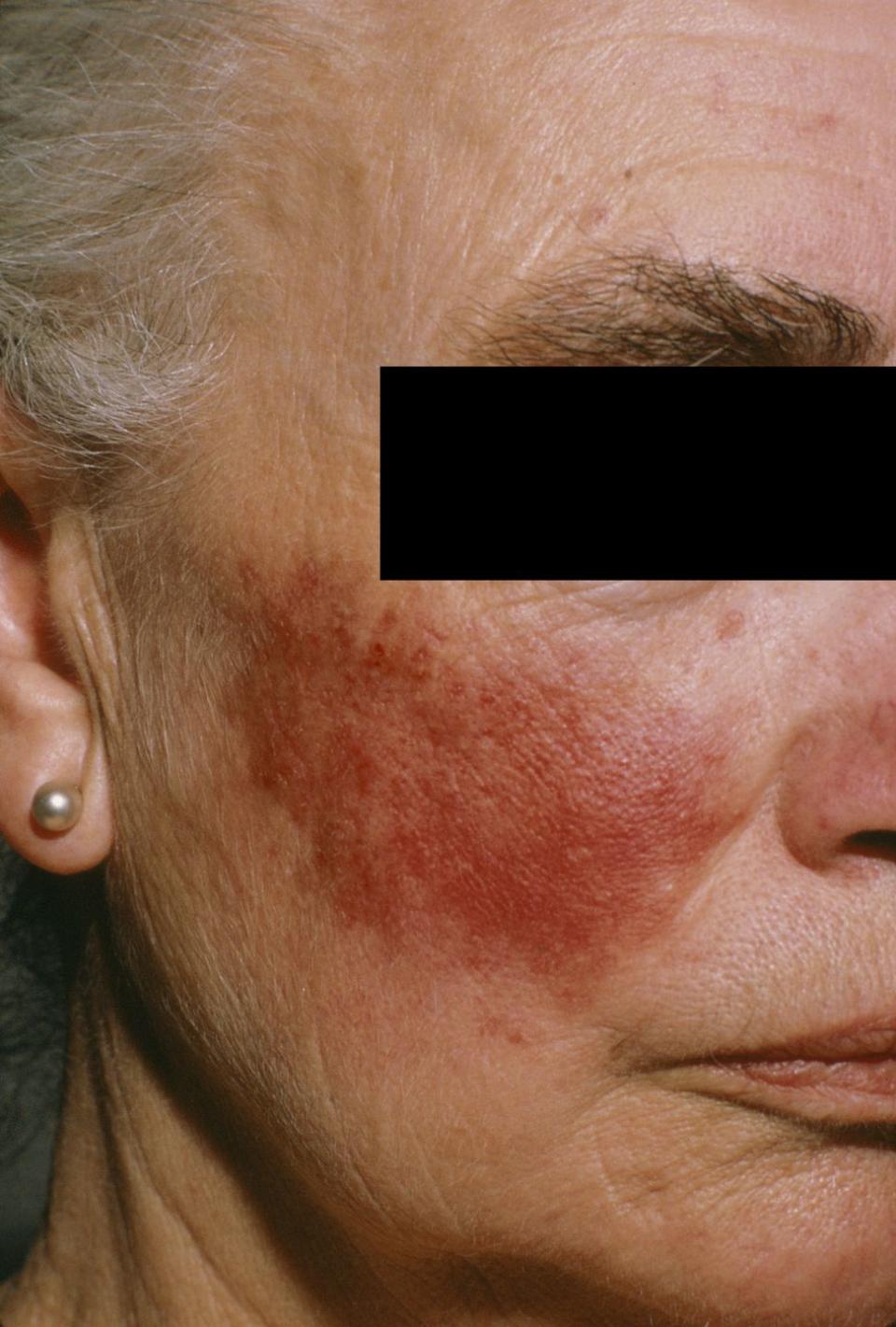
Sunburn
You may know a sunburn can cause red skin immediately, but did you know that sun damage can build up? “Over time, sun damage can cause red vessels and a ‘ruddy’ facial complexion,” Dr. Adigun says. A burn will feel warm to the touch and be painful, in addition to the skin redness. Peeling is also a common symptom.
Your skin is especially susceptible to sun damage during the summer months when the UV rays are more intense and exposure is prolonged, says Dr. Zubritsky. "UV rays are known to damage our skin and worsen redness," she adds.
She recommends wearing a broad-sepctrum SPF of at least 30 every day with frequent reapplications to prevent further damage. "This is the best way to prevent redness from worsening or forming in the first place," Dr. Zubritsky says.
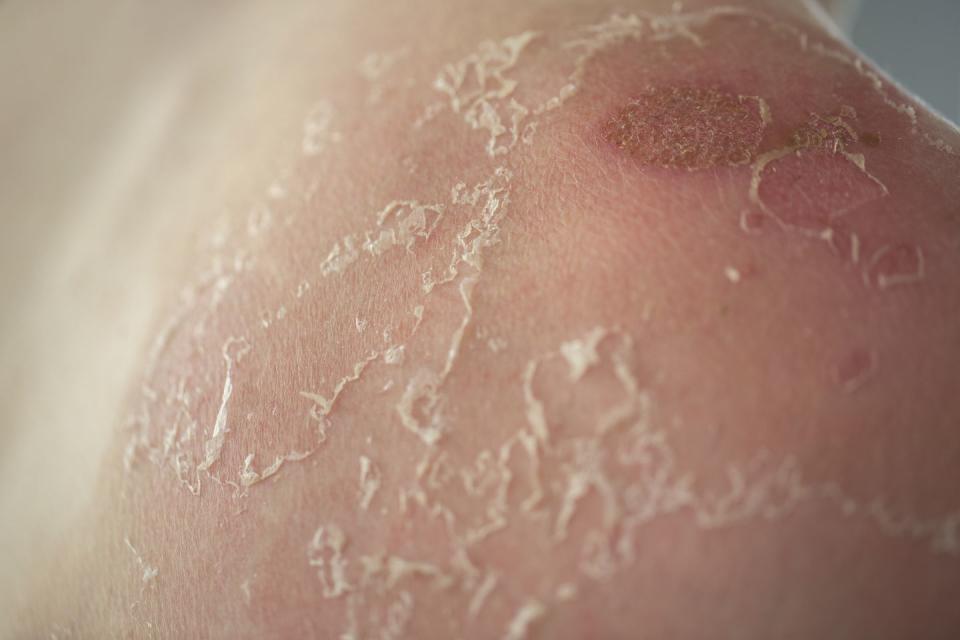
Perioral dermatitis
Perioral dermatitis presents as a bumpy, red rash around the mouth, nose, or eyes. "The rash can burn, sting, or be itchy, and often occurs after a trigger, such as cold weather, use of topical steroids on the face, or new cosmetic products," Dr. Adigun says. See a doctor if you have new red bumps or a rash with skin sensitivity after trying new makeup or face products that persists for two or more weeks.
Common treatments include immunosuppressive creams, such as Elidel or Protopic, topical antibiotics, such as Metrogel and Noritate, and oral antibiotics when the case is more severe.
Seborrheic dermatitis
Seborrheic dermatitis, also known as dandruff, actually starts off as cradle cap—patchy and scaly skin on the top of the head—in babies. Some of us never grow out of it, Dr. Adigun says.
"This condition not only occurs in the scalp, but commonly occurs on the face in areas like the eyebrows, nasolabial folds, cheeks, beard area, and ears," Dr. Zubritsky notes. "This is due to overgrowth of a yeast on our skin called Malassezia." It often presents with redness and greasy yellow scales on the face.
It's treated with a combination of anti-inflammatory treatments like cortisone and antifungals, which target the yeast.
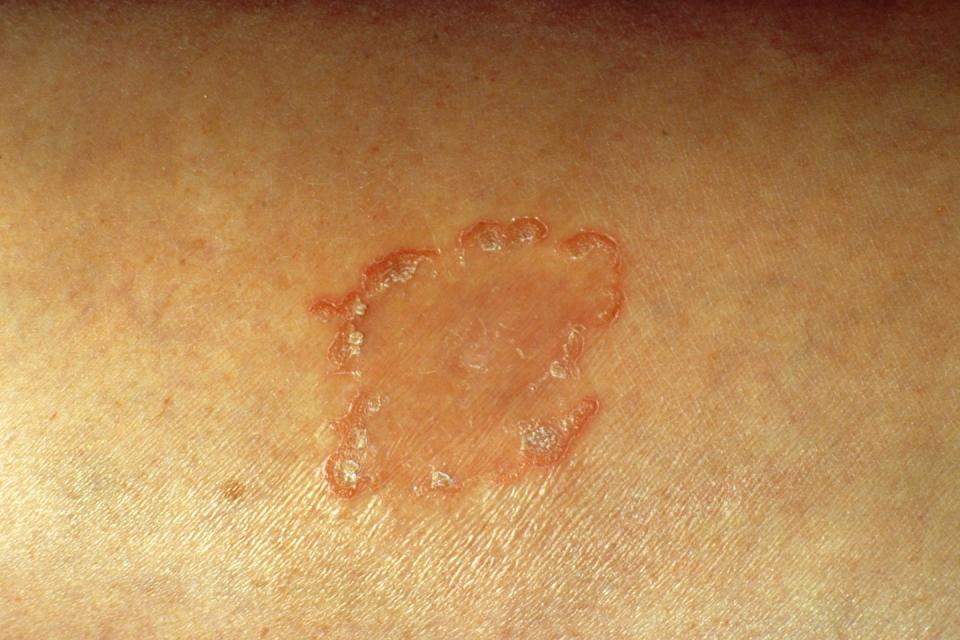
How do I know when I should get medical help for my skin redness?
There are so many different reasons you might have red skin, which means it can be serious or NBD. What really matters is the other symptoms you get besides the redness. As a rule of thumb, if you're in a lot of pain, have a fever, think you may have an infection, or see serious swelling that isn’t going away, check in with your doctor or a dermatologist. They can help you get the meds you need to calm your skin and treat the root cause.
"It's important to figure out the underlying cause—that way, you can develop a plan to prevent it from happening again," Dr. Charles says. If your skin is consistently irritated, talking to a derm about stressors and causes is a good next step.
You Might Also Like

